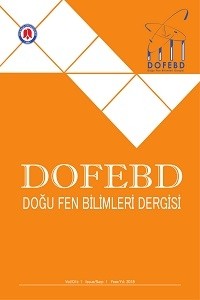Biebersteinia multifida DC. ve Biebersteinia orphanidis Boiss. (Biebersteiniaceae Stephan) Türleri Üzerinde Karyomorfolojik Araştırma
Bu çalışmada taksonomik konumu uzun süredir tartışmalı olan Biebersteinia Steph‘in Türkiyede doğal yayılış gösteren B. multifida DC. ve B.orphanidis Boiss. türlerinin mitotik metafaz kromozomları incelenmiştir. B.multifida DC. türünün ortalama kromozom uzunluğu 5.88 μm, karyotip formülü 2n=10=6sm+4st olarak belirlenmiştir ve kromozom simetrisi 4A sınıfındadır. B.orphanidis Boiss. türünün ise ortalama kromozom uzunluğu 7.49μm, karyotip formülü 2n=10=6sm+4m olarak belirlenmiştir ve kromozom simetrisi 3A sınıfındadır.
Anahtar Kelimeler:
Biebersteinia Steph., karyomorfoloji, sistematik
___
- Boissier, E., (1867). Biebersteiniae in flora Orientalis. Vol.1, H. Georg, Basilee. Cenevre pp.899-900.
- Bortenschlager, S., (1967). Vorlaufige mitteilungen zur pollenmorphologie in der sequences from der Geraniaceen und ihre systematische Bedeutumg. Grana Palynol. 7:400-468.
- Constantinidis,T.A.,(1996).Biebersteinia orphanidis Boiss. Flora Mediterranea 6:308-312.
- Cronquist, A., (1981). An integrated system of classification of the flowering plants. Columbia Universty press. Newyork. 828-831.
- Cronquist, A., (1988). The evolution and classification of flowering plants. 2nd.edn. New York Botanical Garden. Newyork.
- Dahlgreen, R.T., (1989). The last dahlgenogram system of classification of the dicothyledones. In K.Tan (ed). The Davis and Hedge Festchrift. Edinburg Universty Press.Edinburg.249-260.
- Davis, PH., (1967). Flora of Turkey and the east aegean ısland. Volume 2.Edinburg. 450-451.7
- De Candolle, A.P., (1924). Prodromus systematis naturalis regni vegetabilis. sive enumerato contracta ordinum generum specierumque plantarum. Vol.1.Argentorati and Londini. Paris.pp.707.
- Elçi, Ş. (1994). Sitogenetikte araştırma yöntemleri ve gözlemler. Yüzüncü Yıl Üniv. Yayınları 18 Van. 238 s.
- Elçi, Ş., Sancak, C. (2013). Sitogenetikte araştırma yöntemleri ve gözlemler. Ankara Üniversitesi Yayınevi, Ankara, 227 s.
- Endlicher, S.L., (1841). Biebersteiniaceae. In Enchiridion botanicum. W.Engelman Leipzig.
- Güner, A., Aslan, S., Ekim, T., Babaç, M.T., (edlr). (2012). Türkiye bitkileri listesi (damarlı bitkiler). Nezahat Gökyiğit Botanik Bahçesi ve Flora Araştırmaları Derneği yayını.İstanbul.
- Liu, JQ., Ho.TN., Chen. S., Lu. A., (2001). Karyomorphology of Biebersteinia Stephan (Geraniaceae) and its systematic and taxonomic significance. Bot. Bull. Acad. Sin. 42:61-66.
- Knuth, R. (1912). Biebersteinia Steph. In: Engler A, ed. Das Pflanzenreich, vol. 53. Berlin, 546–549.
- Knuth, R., (1912). Geraniaceae in: A. Engler (ed.). Das Pfanzenreich IV.129. Berlin. Pp.1-640.
- Levan, A., Fredga, K., Sandberg, A.A. (1964). Nomenclature for centromeric position on chromosomes. Hereditas, 52, 201-220.
- Nasır, J.Y., (1979). Biebersteiniaceae in flora of west Pakistan.Islamabad.129, 1-3.
- Rechinger, K.H., (1970). Flora Iranica. Volume:63, Geraniaceae. Akademische Druck und Verlagsanstalg Graz. Salzburg
- Stebbins, G.L., (1971). Chromosomal evolution in higher plants. Edward Arnold (Pulishers)Ltd. London.
- Tutel, B., (1982).Comparison of the taxonomy and leaf anatomy of the genus Biebersteinia with the other genera of Geraniaceace of Turkey. İstanbul Üniversitesi Fen Fakültesi Dergisi.B:4748:5186.
- Takhtajan, A., (1987). Systema Magnoliophytorum. Officina Editoria ‘’Nauka’’, Leningrad.
- Thorne, R.F., (1992). An updated phylogenetic classification of the flowering plants. A Journal of Systematic and Evolutionary Botany Aliso 13:365-389.
- ISSN: 2667-6958
- Yayın Aralığı: Yılda 2 Sayı
- Başlangıç: 2018
- Yayıncı: Hakkari Üniversitesi
Sayıdaki Diğer Makaleler
Düzce Üniversitesi Kampüsünde Kuş Halkalama Metodu Uygulanarak Avifaunanın Belirlenmesi
Gmelina asiatica L. Ekstraktlarının Biyolojik Aktiviteleri
Vinujan SHANMUGALİNGAM, Saravanan VİVEKANANDARAJAH SATHASİVAMPİLLAİ, Pholtan Rajeev SEBASTİAN
ALTI FARKLI BİTKİ TÜRÜNÜN ALLELOPATİK AKTİVİTELERİNİN BELİRLENMESİ
